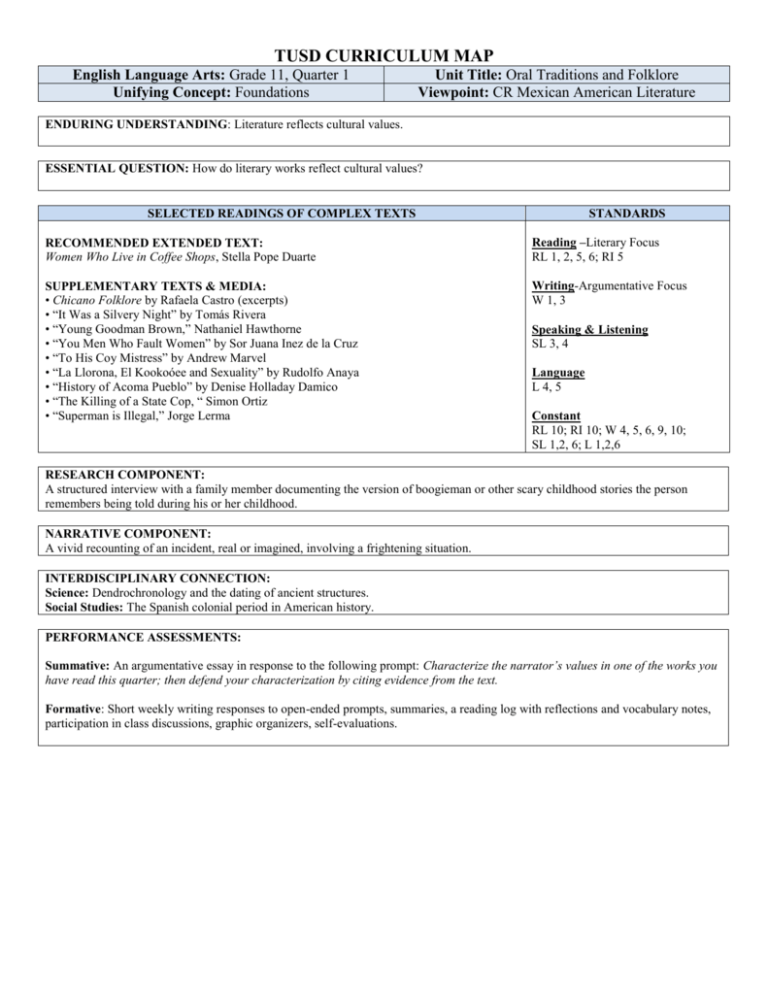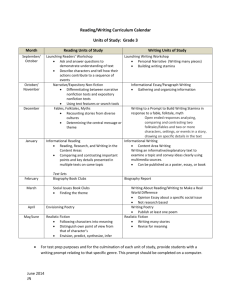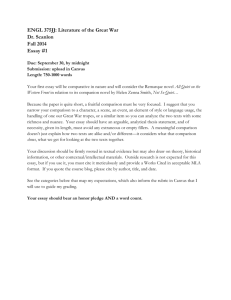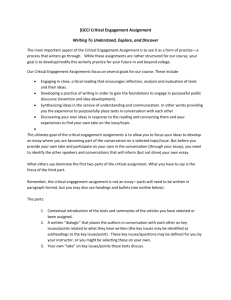Mexican American Literature
advertisement

TUSD CURRICULUM MAP English Language Arts: Grade 11, Quarter 1 Unifying Concept: Foundations Unit Title: Oral Traditions and Folklore Viewpoint: CR Mexican American Literature ENDURING UNDERSTANDING: Literature reflects cultural values. ESSENTIAL QUESTION: How do literary works reflect cultural values? SELECTED READINGS OF COMPLEX TEXTS STANDARDS RECOMMENDED EXTENDED TEXT: Women Who Live in Coffee Shops, Stella Pope Duarte Reading –Literary Focus RL 1, 2, 5, 6; RI 5 SUPPLEMENTARY TEXTS & MEDIA: • Chicano Folklore by Rafaela Castro (excerpts) • “It Was a Silvery Night” by Tomás Rivera • “Young Goodman Brown,” Nathaniel Hawthorne • “You Men Who Fault Women” by Sor Juana Inez de la Cruz • “To His Coy Mistress” by Andrew Marvel • “La Llorona, El Kookoóee and Sexuality” by Rudolfo Anaya • “History of Acoma Pueblo” by Denise Holladay Damico • “The Killing of a State Cop, “ Simon Ortiz • “Superman is Illegal,” Jorge Lerma Writing-Argumentative Focus W 1, 3 Speaking & Listening SL 3, 4 Language L 4, 5 Constant RL 10; RI 10; W 4, 5, 6, 9, 10; SL 1,2, 6; L 1,2,6 RESEARCH COMPONENT: A structured interview with a family member documenting the version of boogieman or other scary childhood stories the person remembers being told during his or her childhood. NARRATIVE COMPONENT: A vivid recounting of an incident, real or imagined, involving a frightening situation. INTERDISCIPLINARY CONNECTION: Science: Dendrochronology and the dating of ancient structures. Social Studies: The Spanish colonial period in American history. PERFORMANCE ASSESSMENTS: Summative: An argumentative essay in response to the following prompt: Characterize the narrator’s values in one of the works you have read this quarter; then defend your characterization by citing evidence from the text. Formative: Short weekly writing responses to open-ended prompts, summaries, a reading log with reflections and vocabulary notes, participation in class discussions, graphic organizers, self-evaluations. TUSD CURRICULUM MAP English Language Arts: Grade 11, Quarter 2 Unifying Concept: Perceptions Unit Title: Chicano Renaissance Viewpoint: CR Mexican American Literature ENDURING UNDERSTANDING: The reader’s interaction with text can lead to self-discovery. ESSENTIAL QUESTION: What can we learn about ourselves by reading about other people’s lives? SELECTED READINGS OF COMPLEX TEXTS STANDARDS RECOMMENDED EXTENDED TEXT: Always Running, Luis Rodriguez Reading –Informational Focus RL 3, 4; RI 1, 2, 3, 7, 8, 9 SUPPLEMENTARY TEXTS & MEDIA: • The Original Sin, Anthony Quinn (excerpt) • Ulises Criollo, José Vasconcelos (excerpt) • “I Am Joaquín,” Rodolfo Gonzales • Los Vendidos, Luis Valdez • The Ballad of Gregorio Cortez http://www.youtube.com/watch?v=YlrP2IR58es • “El Hoyo,” Mario Suárez • La Bamba (1987 DVD) • “La Adelita,” traditional ballad • “Desamor,” Rosario Castellanos • “Sonnet 30,” William Shakespear • “The Proclamation of 1867,” Benito Juárez • “The Gettysburg Address,” Abraham Lincoln Writing-Explanatory Focus W2 Speaking & Listening SL 5 Language L 3, 4 Constant RL 10; RI 10; W 4, 5, 6, 9, 10; SL 1,2, 6; L 1,2,6 RESEARCH COMPONENT: A study of surnames, given names and nicknames that requires students to identify the etymology, denotation and classification of their surnames, and to also trace the origins of their given names and nicknames. NARRATIVE COMPONENT: After reading the excerpt from The Original Sin, students will compose a narrative essay briefly detailing how the student’s parents or grandparents met. INTERDISCIPLINARY CONNECTION: Geology: Features of the Chihuahuan Desert Social Studies: The Mexican revolution of 1910. PERFORMANCE ASSESSMENTS: Summative: An explanatory essay of at least 500 words in response to the following prompt: Compare the Luis Rodriguez memoir (published in 1993) to the Quinn autobiography (published in 1972). What differences and similarities do you find between the two works? Formative: An essay comparing and contrasting the Gettysburg Address and the Proclamation of 1867, describing the purposes and rhetorical elements found in each work. TUSD CURRICULUM MAP English Language Arts: Grade 11, Quarter 3 Unifying Concept: Transformations Unit Title: Family and Kinship Viewpoint: CR Mexican American Literature ENDURING UNDERSTANDING: What makes a story interesting is the way it is told. ESSENTIAL QUESTION: What techniques do authors use to enhance the reader’s interest in a story? SELECTED READINGS OF COMPLEX TEXTS STANDARDS RECOMMENDED EXTENDED TEXT: Mexican Whiteboy, Matt De La Peña Reading –Literary Focus RL 7, 9; RI 4 SUPPLEMENTARY TEXTS & MEDIA: • Nobody’s Son, Luis Alberto Urrea (excerpts) • “Carmen’s Song” and “Blackjack,” Alicia Gaspar de Alba • Martin and Meditations on the South Valley, Jimmy Santiago Baca (excerpts) • “Upon the Burning of Our House,” Anne Bradstreet • “A Marriage of Mutes,” Ana Castillo • “Perras,” Sandra Cisneros • “Building a Mountain” and “Cutting Away,” David Rice • Mi Familia (1995 DVD) • “ ‘Mexican’ Is Not a Noun,” Francisco Alarcón • Cholos & Surfers, Jack López (excerpts) • White By Law, Ian Haney-López (excerpts) Writing-Explanatory Focus W 2, 7, 8 Speaking & Listening SL 3 Language L5 Constant RL 10; RI 10; W 4, 5, 6, 9, 10; SL 1,2, 6; L 1,2,6 RESEARCH COMPONENT: A library or on-line search for a quotation about family, fathers, mothers, daughters or sons, elaborated upon with an original paraphrasing and a written reflection about the quotation, including some details about the person quoted. NARRATIVE COMPONENT: A narrative essay about a time when the student suffered—or committed—an injustice. INTERDISCIPLINARY CONNECTION: Science: The use of DNA to trace ancestry. Social Studies: The history of eugenics in the United States. PERFORMANCE ASSESSMENTS: Summative: An explanatory essay in response to the following prompt: What literary techniques does De La Peña use to enhance the reader’s interest in his novel? Formative: Short weekly writing responses to open-ended prompts, summaries, a reading log with reflections and vocabulary notes, participation in class discussions. TUSD CURRICULUM MAP English Language Arts: Grade 11, Quarter 4 Unifying Concept: Realizations Unit Title: Fate and Choice Viewpoint: CR Mexican American Literature ENDURING UNDERSTANDING: Although nonfiction authors present factual information about real people, places, and events, they may shape the information according to purpose and viewpoint. ESSENTIAL QUESTION: How does the purpose and viewpoint taken by non-fiction authors shape the information they present? SELECTED READINGS OF COMPLEX TEXTS STANDARDS RECOMMENDED EXTENDED TEXT: The Devil’s Highway, Luis Alberto Urrea Reading –Informational Focus RL 5; RI 4, 6, 9 SUPPLEMENTARY TEXTS & MEDIA: • “The Irish Orphan Abduction,” Margaret Regan • Lone Star (1999 DVD) • Capirotada: A Nogales Memoir, Alberto Ríos (excerpts) • Crossing Borders: Personal Essays, Sergio Troncoso (excerpts) • “Immigrants,” Pat Mora Writing-Argumentative Focus W1 Speaking & Listening SL 3, 4, 5 Language L3 Constant RL 10; RI 10; W 4, 5, 6, 9, 10; SL 1,2, 6; L 1,2,6 RESEARCH COMPONENT: Mapping and naming separate neighborhood boundaries within the school’s attendance area. NARRATIVE COMPONENT: An essay detailing the way students perceive zones, borders and boundaries in their homes, the school and in the neighborhoods where they live. For example, in a four-passenger vehicle, which seat is zoned as having the lowest status? INTERDISCIPLINARY CONNECTION: Math and Science: Land surveying techniques used to identify borders and boundaries. Social Studies: The Gadsden Purchase. PERFORMANCE ASSESSMENTS: Summative: An argumentative essay in response to the following prompt: Based on the description provided by Urrea in The Devil’s Highway, determine who is most responsible for causing the tragic events described in the book, and support your position with textual evidence. Formative: Short weekly writing responses to open-ended prompts, summaries, a reading log with reflections and vocabulary notes, participation in class discussions.






